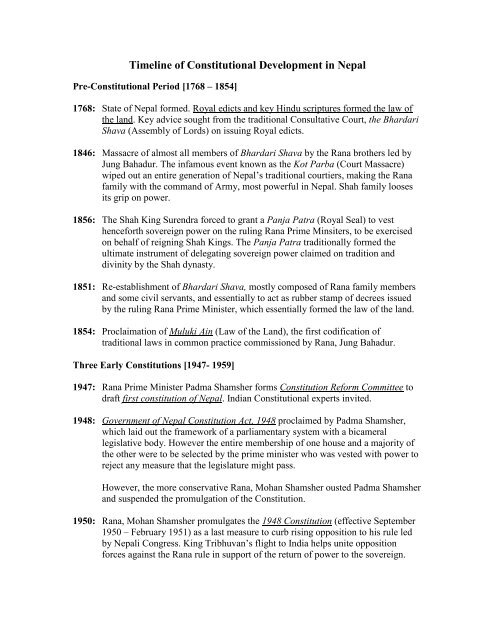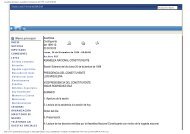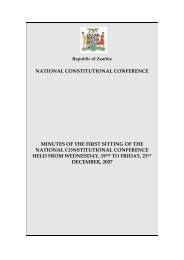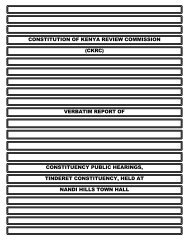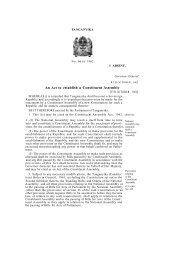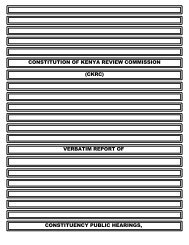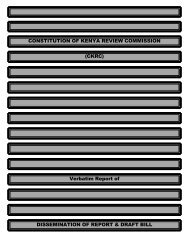Timeline of Constitutional Development in Nepal - ConstitutionNet
Timeline of Constitutional Development in Nepal - ConstitutionNet
Timeline of Constitutional Development in Nepal - ConstitutionNet
Create successful ePaper yourself
Turn your PDF publications into a flip-book with our unique Google optimized e-Paper software.
<strong>Timel<strong>in</strong>e</strong> <strong>of</strong> <strong>Constitutional</strong> <strong>Development</strong> <strong>in</strong> <strong>Nepal</strong>Pre-<strong>Constitutional</strong> Period [1768 – 1854]1768: State <strong>of</strong> <strong>Nepal</strong> formed. Royal edicts and key H<strong>in</strong>du scriptures formed the law <strong>of</strong>the land. Key advice sought from the traditional Consultative Court, the BhardariShava (Assembly <strong>of</strong> Lords) on issu<strong>in</strong>g Royal edicts.1846: Massacre <strong>of</strong> almost all members <strong>of</strong> Bhardari Shava by the Rana brothers led byJung Bahadur. The <strong>in</strong>famous event known as the Kot Parba (Court Massacre)wiped out an entire generation <strong>of</strong> <strong>Nepal</strong>’s traditional courtiers, mak<strong>in</strong>g the Ranafamily with the command <strong>of</strong> Army, most powerful <strong>in</strong> <strong>Nepal</strong>. Shah family loosesits grip on power.1856: The Shah K<strong>in</strong>g Surendra forced to grant a Panja Patra (Royal Seal) to vesthenceforth sovereign power on the rul<strong>in</strong>g Rana Prime M<strong>in</strong>siters, to be exercisedon behalf <strong>of</strong> reign<strong>in</strong>g Shah K<strong>in</strong>gs. The Panja Patra traditionally formed theultimate <strong>in</strong>strument <strong>of</strong> delegat<strong>in</strong>g sovereign power claimed on tradition anddiv<strong>in</strong>ity by the Shah dynasty.1851: Re-establishment <strong>of</strong> Bhardari Shava, mostly composed <strong>of</strong> Rana family membersand some civil servants, and essentially to act as rubber stamp <strong>of</strong> decrees issuedby the rul<strong>in</strong>g Rana Prime M<strong>in</strong>ister, which essentially formed the law <strong>of</strong> the land.1854: Proclaimation <strong>of</strong> Muluki A<strong>in</strong> (Law <strong>of</strong> the Land), the first codification <strong>of</strong>traditional laws <strong>in</strong> common practice commissioned by Rana, Jung Bahadur.Three Early Constitutions [1947- 1959]1947: Rana Prime M<strong>in</strong>ister Padma Shamsher forms Constitution Reform Committee todraft first constitution <strong>of</strong> <strong>Nepal</strong>. Indian <strong>Constitutional</strong> experts <strong>in</strong>vited.1948: Government <strong>of</strong> <strong>Nepal</strong> Constitution Act, 1948 proclaimed by Padma Shamsher,which laid out the framework <strong>of</strong> a parliamentary system with a bicamerallegislative body. However the entire membership <strong>of</strong> one house and a majority <strong>of</strong>the other were to be selected by the prime m<strong>in</strong>ister who was vested with power toreject any measure that the legislature might pass.However, the more conservative Rana, Mohan Shamsher ousted Padma Shamsherand suspended the promulgation <strong>of</strong> the Constitution.1950: Rana, Mohan Shamsher promulgates the 1948 Constitution (effective September1950 – February 1951) as a last measure to curb ris<strong>in</strong>g opposition to his rule ledby <strong>Nepal</strong>i Congress. K<strong>in</strong>g Tribhuvan’s flight to India helps unite oppositionforces aga<strong>in</strong>st the Rana rule <strong>in</strong> support <strong>of</strong> the return <strong>of</strong> power to the sovereign.
“Delhi Compromise” between K<strong>in</strong>g and the Ranas facilitated by the NehruGovernment <strong>in</strong> India ended the Rana rule.1951: K<strong>in</strong>g Tribhuvan returns and addresses people <strong>of</strong> <strong>Nepal</strong> on his <strong>in</strong>terest to have anew system <strong>of</strong> rule under a “Republican Constitution” passed by “a legislativeparliament formed by adult suffrage”, the Constituent Assembly (CA). Cited <strong>in</strong>Sudha Nath Panta (2006: 134) <strong>Nepal</strong> ko Kanuni Byabastha ra Prajatantra koBikas ko darpan (<strong>Nepal</strong>’s Legal System and the Democracy’s <strong>Development</strong>Mirror)The Interim Constitution, entitled Interim Government <strong>of</strong> <strong>Nepal</strong> Act 1951, draftedwith the help <strong>of</strong> Indian experts and to a considerable extent based on theConstitution <strong>of</strong> India, asserted K<strong>in</strong>g’s executive, legislative and judicial powers.However, the election to the CA is not held. K<strong>in</strong>g Tribhuvan appo<strong>in</strong>ts multiple<strong>in</strong>terim governments until his death <strong>in</strong> 1955. K<strong>in</strong>g Mahendra cont<strong>in</strong>ues with theexperiments by appo<strong>in</strong>t<strong>in</strong>g various governments stall<strong>in</strong>g the election to CA.1959: Royal Constitution <strong>of</strong> 1959 proclaimed by K<strong>in</strong>g Mahendra cit<strong>in</strong>g traditional anddiv<strong>in</strong>e sovereignty vested on him, on February 12, 1959 replac<strong>in</strong>g the <strong>in</strong>terim act<strong>of</strong> 1951. The constitution provides expansive power for the K<strong>in</strong>g.In less than a week, on February 18, 1959, first legislature elected <strong>in</strong> <strong>Nepal</strong>’shistory by adult franchise. B.P. Koirala becomes first democratically electedPrime M<strong>in</strong>ister <strong>of</strong> <strong>Nepal</strong>.Return to Autocracy I [1960- 1989]1960 K<strong>in</strong>g Mahendra dismisses Prime M<strong>in</strong>ister Koirala government, enacts emergencyrule and suspends the 1959 constitution.1962: Proclamation <strong>of</strong> Constitution <strong>of</strong> 1962 by K<strong>in</strong>g Mahendra establish<strong>in</strong>g thePanchayat system. The traditional village council system <strong>of</strong> five (Panch) eldersprevalent <strong>in</strong> the Indian sub-cont<strong>in</strong>ent expanded to the national level <strong>in</strong> a four-tiersystem. Political parties banned.Although the constitution provided for a unicameral legislature, the Rastriya(National) Panchayat, this has no mean<strong>in</strong>gful power. The constitutionconsolidated the K<strong>in</strong>g’s power <strong>in</strong> governance.1967: First Amendment <strong>of</strong> Panchayat Constitution. Partylessness emphasized as thedef<strong>in</strong><strong>in</strong>g character <strong>of</strong> the system. K<strong>in</strong>g given added power to appo<strong>in</strong>t to keyadm<strong>in</strong>istrative positions.1975: Second Amendment <strong>of</strong> Panchayat Constitution. Seeks to covert the country <strong>in</strong>tosoviet style s<strong>in</strong>gle party state with political and quasi judicial agencies like “Back
to Village National Campaign” and “Panchayat Policy and InvestigationCommittee” <strong>in</strong>vested with wide rang<strong>in</strong>g power to monitor and implement the“Panchyati norms and values”.1979: Nationwide student protests demand<strong>in</strong>g democracy1980: National Referendum (May) held on the question <strong>of</strong> return to multi-partydemocracy or cont<strong>in</strong>u<strong>in</strong>g the Panchayat system with reforms.The allegedly rigged referendum result favour reform <strong>in</strong> Panchayat system with asmall majority –55% aga<strong>in</strong>st the 45% support registered for multi-party system.Third Amendment <strong>of</strong> Panchayat Constitution (December) provides for the directelection <strong>of</strong> the representatives <strong>of</strong> the national legislature, the Rastriya Panchayatand other local bodies like Nagar (city) Panchayat and Gaun (village) Panchayat.1981: First direct election <strong>of</strong> Panchayat. One third voted <strong>in</strong> are members <strong>of</strong> banned<strong>Nepal</strong>i Congress Party.1986: Second direct election <strong>of</strong> Panchayat. More members <strong>of</strong> the banned parties electedto the national legislature. Grow<strong>in</strong>g rift among Royal supporters.Second Democratic Experience [1990- 2001]1990: People’s Movement for the restoration <strong>of</strong> multi-party democracy (April). K<strong>in</strong>gBirendra bows to popular pressure after 55 days <strong>of</strong> protests nationwide, lifts banon political parties, abrogates various Panchyat bodies <strong>in</strong>clud<strong>in</strong>g the RastriyaPanchayat (April)Formation <strong>of</strong> <strong>in</strong>terim government led by <strong>Nepal</strong>i Congress leader K.P. Bhattaraiannounced with representation by Communist Party and the civil society. K<strong>in</strong>gsubsequently vests executive and legislative authority <strong>in</strong> the <strong>in</strong>terim government.N<strong>in</strong>e member Constitution Reform Commission announced with representativesfrom the <strong>Nepal</strong>i Congress, Communist Party and Royal representatives (May).Constitution <strong>of</strong> K<strong>in</strong>gdom <strong>of</strong> <strong>Nepal</strong> 1990 promulgated by K<strong>in</strong>g Birendra(November)1991: First general election held under the new constitution (May 1991).Girija Prasad Koirala <strong>of</strong> <strong>Nepal</strong>i Congress (NC) forms the majority government.1992: First case <strong>of</strong> judicial review under new constitution. K<strong>in</strong>g’s royal prerogative reassertedwith the Supreme Court rul<strong>in</strong>g K<strong>in</strong>g’s appo<strong>in</strong>tment <strong>of</strong> ambassador notsubject to question <strong>in</strong> the court.
1994: K<strong>in</strong>g advised to dissolve the parliament and election date set by Prime M<strong>in</strong>isterKoirala after a period <strong>of</strong> factional fight<strong>in</strong>g <strong>in</strong> NC. Opposition parties file writpetition <strong>in</strong> the Supreme Court to annul the decision.Second case <strong>of</strong> Judicial Review. Supreme Court rules <strong>in</strong> favour <strong>of</strong> PrimeM<strong>in</strong>ister’s power to dissolve the house and call for early election as a leader <strong>of</strong>majority.Early election held. Man Mohan Adhikary <strong>of</strong> CPN – UML becomes the firstcommunist Prime M<strong>in</strong>ister <strong>in</strong> a Monarchy head<strong>in</strong>g a m<strong>in</strong>ority government <strong>in</strong> thehung parliament (November).1995: Man Mohan Adhikary government <strong>of</strong> CPN-UML advises K<strong>in</strong>g to dissolve theParliament and set election date <strong>in</strong> a bid to ward <strong>of</strong>f vote <strong>of</strong> confidence demandedby the opposition parties. Opposition parties file writ petition <strong>in</strong> Supreme Court toannul the decision.Third case <strong>of</strong> Judicial Review with<strong>in</strong> a year. Supreme Court rules that PrimeM<strong>in</strong>ister Man Mohan Adhikary's recommendation <strong>in</strong> June to have parliamentdissolved for re-election was unconstitutional (August). This decision is <strong>in</strong>contrast to the 1994 decision <strong>in</strong> favour <strong>of</strong> Prime M<strong>in</strong>isterial to advise dissolution.M<strong>in</strong>ority Adhikary government defeated <strong>in</strong> a vote <strong>of</strong> confidence. Sher BahadurDeuba <strong>of</strong> NC forms coalition government <strong>of</strong> NC, National Democratic Party(Rastriya Prajatantra Party – RPP) and <strong>Nepal</strong> Sadhbhavana Party (NSP).1996: Communist Party <strong>of</strong> <strong>Nepal</strong> – Maoist submits 40 po<strong>in</strong>ts demand to the governmentwith ultimatum to launch war if the demands not met.People’s war launched by CPN – Maoist (February)1997: Sher Bahadur Deuba government loses vote <strong>of</strong> confidence <strong>in</strong> parliament. Secondtime a NC government collapses due to the <strong>in</strong>fight<strong>in</strong>g (March).Lokendra Bahadur Chand <strong>of</strong> RPP forms government with back<strong>in</strong>g <strong>of</strong> CPN –UML’s Bam Dev Gautam faction. NSP rema<strong>in</strong>s another coalition partner.Chand government is replaced by the Surya Bahadur Thapa faction <strong>of</strong> RPP <strong>in</strong>coalition with NC and NSP.1998: Surya Bahadur Thapa is pressured by Girija Prasad Koirala to resign.Surya Bahadur Thapa advises K<strong>in</strong>g to dissolve Parliament and set date forelection.
K<strong>in</strong>g seeks Supreme Court’s op<strong>in</strong>ion on the issue cit<strong>in</strong>g the preced<strong>in</strong>gcontradictory rul<strong>in</strong>gs by the court. Supreme Court advises Prime M<strong>in</strong>ister doesnot have power to dissolve the Parliament.Surya Bahadur Thapa resigns.A coalition government under Girija Koirala with UML and NSP as partnersformed to hold approach<strong>in</strong>g qu<strong>in</strong>quennial election.1999: Third general election held under 1990 Constitution br<strong>in</strong>gs back NC majority <strong>in</strong>the parliament. Krishna Prasad Bhattarai, a rival <strong>of</strong> Girija Prasad Koirala <strong>in</strong> NCbecomes Prime M<strong>in</strong>ister.2000: Girija Prasad Koirala replaces Krishna Prasad Bhattarai as Prime M<strong>in</strong>ister.2001: Royal Massacre <strong>in</strong> June 1. All family members <strong>of</strong> K<strong>in</strong>g Birendra are killed.Pr<strong>in</strong>ce Gyanendra becomes new K<strong>in</strong>g.Girija Prasad Koirala resigns due to opposition from his party. Sher BahadurDeuba becomes Prime M<strong>in</strong>ister aga<strong>in</strong>.Peace negotiation started with Maoists.Maoists walk out <strong>of</strong> the peace process with attack on the Army barracks.Emergency rule declared.Return to Autocracy II [2002- 2006]2002: K<strong>in</strong>g dissolves Parliament on the advice <strong>of</strong> Prime M<strong>in</strong>ister Deuba (May). Date fornew election set for November.2002: Prime M<strong>in</strong>ister Deuba advises K<strong>in</strong>g to defer elections by a year cit<strong>in</strong>g worsen<strong>in</strong>gsecurity situation (October) after consultation with major political parties.K<strong>in</strong>g removes Prime M<strong>in</strong>ister Deuba from <strong>of</strong>fice and proclaims assumption <strong>of</strong>executive power.Lokendra Bahadur Chand named new Prime M<strong>in</strong>ister by K<strong>in</strong>g.2003: Second round <strong>of</strong> negotiation with Maoists.Chand resigns. Aga<strong>in</strong>st the counsel <strong>of</strong> political parties, K<strong>in</strong>g appo<strong>in</strong>ts SuryaBahadur Thapa as Prime M<strong>in</strong>ister.
2004: Surya Bahadur Thapa resigns. K<strong>in</strong>g appo<strong>in</strong>ts Sher Bahadur Deuba as PrimeM<strong>in</strong>ister, the man he had sacked <strong>in</strong> 2002 for alleged <strong>in</strong>competence to holdelection on the announced date.2005: K<strong>in</strong>g removes Deuba from <strong>of</strong>fice second time <strong>in</strong> less than two years (February).Proclaims himself as the chief executive and head <strong>of</strong> the council <strong>of</strong> m<strong>in</strong>isters.Twelve po<strong>in</strong>t agreement on the “Road Map <strong>of</strong> Peace and Democracy” reachedbetween the Seven Party Alliance (SPA) – the parties represented <strong>in</strong> the dissolvedparliament, and CPN-Maoists to launch jo<strong>in</strong>t struggle aga<strong>in</strong>st K<strong>in</strong>g Gyanendra’sdirect rule (November).Return to democracy2006: Massive demonstration aga<strong>in</strong>st the K<strong>in</strong>g’s rule leads to the K<strong>in</strong>g re<strong>in</strong>stat<strong>in</strong>gdissolved parliament, the House <strong>of</strong> Representative, first elected <strong>in</strong> 1999.Proclamation <strong>of</strong> K<strong>in</strong>g Gyanendra, re<strong>in</strong>stat<strong>in</strong>g the dissolved parliament (April).Interim government <strong>of</strong> seven party alliance (SPA) sworn <strong>in</strong> (April).House <strong>of</strong> Representative issues proclamation 2006, remov<strong>in</strong>g most royalprerogatives. Government <strong>of</strong> <strong>Nepal</strong> replaces His Majesty Government <strong>of</strong> <strong>Nepal</strong>(May)Twenty Five po<strong>in</strong>t cease fire code <strong>of</strong> conduct signed between Government <strong>of</strong><strong>Nepal</strong> and CPN- Maoist (May)Eight Po<strong>in</strong>t Agreement reached between SPA and Maoists on implementation <strong>of</strong>Twelve Po<strong>in</strong>t Agreement and Twenty Five Po<strong>in</strong>t cease fire agreement (June).Interim Constitution Draft Committee formed (June)Comprehensive Peace Agreement signed (November)2007: Interim Constitution <strong>of</strong> <strong>Nepal</strong> 2007 (ICON-2007) promulgated by the House <strong>of</strong>Representative. After which, it dissolves itself (January 15).Later on the same day 330 member Legislature Parliament as provided <strong>in</strong> the<strong>in</strong>terim constitution is convened with 83 members represent<strong>in</strong>g CPN-Maoists.The legislature parliament unanimously passes the ICON-2007 (January).ICON-2007 fixes date for hold<strong>in</strong>g election by June 20, 2007 under article 33under the head<strong>in</strong>g, “State Responsibility”.
Madhesi activists object to the ICON-2007. Terai unrest flares up (January).Prime M<strong>in</strong>ister Koirala’s first address to the nation. Calls for talks to resolveissues raised by ethnic and regional groups (January)Second address to the nation by Prime M<strong>in</strong>ister Koirala. Promises to amend<strong>in</strong>terim constitution to re-structure the state <strong>in</strong>to a federal system and to holdelection to CA by proportional representation as demanded by ethnic and regionalgroups (February)First Amendment to the Interim Constitution <strong>of</strong> <strong>Nepal</strong> 2007 passed by parliament(March)Maoists jo<strong>in</strong> the <strong>in</strong>terim government under ICON-2007 (April)Eight Party meet<strong>in</strong>g fixes new date for hold<strong>in</strong>g election <strong>of</strong> CA by third week <strong>of</strong>November, 2007 (May)Second Amendment to the Interim Constitution <strong>of</strong> <strong>Nepal</strong> 2007 passed by thecab<strong>in</strong>et


